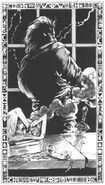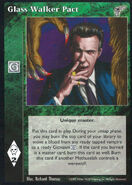The Glass Walkers are one of the thirteen tribes of Garou found in Werewolf: The Apocalypse. Steeped in technology, human religion, and the ebb and flow of the city, the Glass Walkers live and die by a creed of progress. While they fear the Apocalypse as any werewolf, they believe that each passing day makes them stronger, that every new invention may be appropriated for their cause, and that every new philosophy might strengthen their resolve. In this way, Glass Walkers are the quintessential Urrah and don't have the strong aversion to human populations that most Garou do.
History[]
According to tribal legends, the Glass Walkers began as monitors of Humanity on orders of the Silver Fangs, who became intrigued by humanity's creativity and guile. Naturally, given the skeptical outlook most of the tribe possess, they are seen as allegories at best and utter rubbish at worst. Most Glass Walkers also tend to think of the Impergiums as allegories of werewolf activities back in these days.
Earliest History[]

Warders of Apes
In their earliest incarnation, the Glass Walkers were known as the Warders of Apes (or sometimes Warders of Men) and inhabited the region in the Middle East that would eventually become Palestine, hiding themselves in the Jewish population. Evolving side by side with the human inhabitants, the tribe further adapted to city life. When the great Western civilizations like Rome and Carthage arose, the Warders moved in and adapted further, relishing the Greek philosophies and competing with both the Silver Fangs and the various vampire factions for power. This attracted other members of the tribe, resulting in a major migration from the Levant to Italy. The Warders mainly focused on the Roman military and its expansion into the barbaric lands.
At some point in ancient times, the Boli Zousizhe split off from the Warders in China and lost contact with their Western cousins, eventually developing into a distinct culture.
Dark Ages[]

Warders of Men
During this period, the Glass Walkers were called the Warders of Men, City Warders, or simply Warders. The City Warders insinuated themselves into the Church in order to protect themselves from the powerful Leeches that dominated the cities and prospered in the learning centres of medieval Europe. Various Glass Walkers also tried to make the Church more "Gaian", introducing icons of Mary as icons of Gaia and even extended into rural landscapes in the form of monasteries as places of peace and reflection. Other Warders, like those living in the Levant, adopted Islam instead. The religious connotations of the tribe easily overlapped with their duties as Gaia's fangs and also tied the disparate Warders together in a common purpose.
Renaissance[]
During this period, the prevailing Camp was that of the Tetrasomians. The Tetrasomians were alchemists, first formed at the court of the Holy Roman Emperor Frederick II in Sicily. The Tetrasomnians were heavily influenced by Humanism, wanting to create a "Garouism" for werewolves that would champion the rationality and responsibility of the Garou. By balancing the various aspects of their souls, which were modeled after the Greek gods and the Triat, a werewolf would understand both the struggle he had to wage and his place in it. The tribe was modeled like a mystery cult during these days.
The Tribe also began to drift apart during these days, as more and more Tetrasomnians traveled to the New World to make their fortune. Inspired by the ideals of Enlightenment, many of these called for a dissolution of the concept of tribe, seeing it as distracting from the purpose of combating the Wyrm. The Tetrasomnians later perished when they sacrificed themselves to defeat a powerful Bane that had awakened in the industrial landscape of England.
Victorian Age[]

Iron Riders
During this period, the Glass Walkers were known as the Iron Riders, referring to the railroad they used to travel the frontier west.
Rising to prominence due to their involvement in the colonies, the Iron Riders finally found common ground with the rest of the Garou Nation in fighting the native tribes. Following the Industrial Revolution, many Iron Riders dedicated themselves to reducing the harm caused by new technology, and the new banes they created.
Modern Nights[]
In 1895, the Iron Riders changed their name to Glass Walkers, following the discovery of the City Father of London. Dedicated on finding more urban spirit Incarna and securing their aid against the Wyrm, the Glass Walkers weathered both World Wars. In 1999, it was discovered that one of the camps within the tribe, the CyberDogs, had indulged in cybernetic experimentation with unwilling Lupus. The situation quickly escalated into violence, resulting in a near-extermination of the camp and the advent of the Random Interrupts as the dominant power group within the tribe. [1]
Era of Apocalypse (W5 timeline)[]
As the world entered the Era of Apocalypse, Cockroach, the Patron Spirit of the Glass Walkers, fell to the Wyrm. Some accounts claim that this actually occurred as early as the 1960s, Cockroach having been poisoned by the radiation polluting the world and its spirit thanks to the Cold War arms race. In either case, the Garou had to work together to 'put down' Cockroach, and the Glass Walkers were forced to turn to Spider as their new tribal Patron.[2]
Organization[]
The Glass Walkers have few unifying offices. Given the shifting nature of the tribe and its adaptability to human culture, most of the practices stem from the dominant Camp within the Tribe.
Camps[]
- Random Interrupts, the current top dogs of the tribe, who attempt to broaden the horizon of the Garou for new developments in the umbral landscape and explore the world of new technologies, establishing a firm presence on the internet and valuing their top-notch communication.
- Corporate Wolves, who insert themselves strongly in the corporate world and strive to keep Wyrm-influenced corporations like Pentex in check.
- Wise Guys, a camp on the decline that focuses on organized crime. Originally, it had strong ties with the Mafia.
- City Farmers, who cultivate greenscapes within cities in order to nurture enclaves of the Wyld within the webs of the Weaver.
- Dies Ultimae, a doomsday cult and mercenary unit that prepares for the Apocalypse by studying urban tactics and spiritual warfare, even allowing Kinfolk to join their ranks.
- Umbral Pilots, who explore the Deep Umbra for science.
Additionally, there are the CyberDogs, who have dabbled in cyberneticism (and Weaver tech) and tried to machinize Gaia to make her more resilient against the Wyrm. The Camp was stripped of much of its power, but still persist.
Tribal Culture[]
As the tribe most attuned to the ebb and flow of a cosmopolitan urban civilization, the Glass Walkers resist most efforts to categorize them culturally. They do not have a "source culture" in the same way that the Fianna or the Wendigo do, and as such a Glass Walker sept in New York is likely to be entirely different to a Glass Walker sept in Istanbul. However, some generalizations can be made.
Caerns[]
- Sept of the Council for Universal Trade (Hong Kong)
- Sept of the Learning Hall (Moscow, Russia)
- Caern of the Solar Barque (Heliopolis, Cairo, Egypt)
Political Culture[]
The Glass Walkers history and their culture are inextricably intertwined, since as a progressing tribe, their notions of political organization, their goals, and their social roles have all changed. However, the Glass Walker camps drive the political change of the tribe. One camp at any time is considered to hold "dominance" in the tribe by weight of sheer power and success. This is not a formally awarded title and is often applied only after the fact, but it nonetheless represents the way the Glass Walkers work. The dominant camp creates a model for younger werewolves within the tribe to imitate, and thus you see a lot of shifts in the culture of the tribe.
When the first tribebook was published in 1998, the Wise Guys were considered the dominant camp in the tribe. They created a highly formalized, rigid tribal culture that organized politically organized into four "Houses". They were:
- Central House: The Central House were the major leadership house within the tribe. Their duties included selecting the new sept leader (or "Don",) upholding and enforcing the will of the Don, and keeping track of growing Wyrm-taint within a city.
- House of Technological Advancement: Focused on monitoring and creating relationships with new technology spirits within a city.
- House of Urban Defense: Composed of Theurges and Galliards and devoted to the exchange and teaching of rituals down through the tribe, as well as the ritual cleansing of the city from Wyrm-taint.
- House of Rightful Justice: The warfare house of the Glass Walkers, the House of Rightful Justice are responsible for major military operations against Wyrm targets in the city and beyond.
By the time of Glass Walkers Revised in 2002, the Random Interrupts were considered the dominant camp, bringing with them a more fluid tribal structure whose political culture shifted from sept to sept, with most septs being able to be classified as "traditional" (similar to the Wise Guys based structure above), "contemporary" (Corporate Wolf influenced septs based around board meetings and other corporate America influenced practices), or "radical" (Random Interrupt influenced, highly flexible structures with little formal leadership).
As of 5th edition's Era of Apocalypse, the Corporate Wolves - or Glass Walkers who operate akin to them, at the very least - are becoming increasingly common and influential, with many under the new patronage of Spider trying to enact change by becoming successful businesspeople. This has led to no small amount of friction with other tribes due to such Glass Walkers often finding themselves working directly against the interests of Gaia, up to and including founding a Pentex Group front, in the case of the highly controversial Oba Makinde.[3]
Other camps that have been dominant throughout history include: Warders of Men, Tetrasomians, and Iron Riders. The current state of the tribe is a bit strange, as from 1895, it is not called with the name of a previous camp but with a generic name, indicating its current tumultuous situation, since no camp is really prevailing over the others.
Religious Culture[]
To the other Tribes, the Glass Walkers are dangerously close to falling from Gaia, turning wholeheartedly to the Weaver. The Glass Walkers themselves, however, maintain that they are the ones that work to keep the Weaver's work clean from the Taint of the Wyrm. Much of the Tribe is in denial how they are slowly losing contact towards the Wyld, and how Camps dedicated to technologies and the Weaver's song are threatening to overtake their Tribe.
Because of their tight connections with human societies, the Glass Walkers have always held closer connections to human religions than most tribes. Much of this began as camouflage for their own Gaia worship, but as time went on, more formal syncretism came about, including at least one full-blown heresy created by legendary Glass Walker Theurge Gianluigi Lucci. There remains even in the modern tribe a leniency toward such syncretism so long as Gaia is maintained as the only figure whom the Glass Walker serves.
Within their more traditional religious activities, the Glass Walkers honor several unique rituals:
- All Machines Day/The Little Rite: In the first tribebook, All Machines Day was a celebration of technology and The Machine, seeing Glass Walkers cleaning (both literally and spiritually) the machines of their own homes and caerns and then extending to throughout the city. However, the Revised tribebook effectively retconned the idea, replacing it instead with The Little Rite which instead had Glass Walkers performing 'random acts of kindness' to the spirits and people throughout their lives that they often ignore but cannot live without. Both rituals were held on or around the 15th of March each year.
- Memorial Day: Held on various days depending on country, this ritual was designed to honor the Glass Walkers' fallen heroes.
- Promethean Daze: Held toward the end of the year, this Rite crossed New Years bacchanalia with attempts at seer-like prognostication for the oncoming year.
Glass Walker Gifts[]
A full list of the Gifts that the Glass Walkers can access can be found at Glass Walker Gifts.
Individual Glass Walkers[]
Version Differences[]
Gallery[]
Trivia[]
- The Glass Walkers are based on the Benandanti ("Good Walkers"), the Italian Lupo Mannaro and Italian/Roman mythology/folklore on wolves.
- Due to the link to Rome, the Glass Walkers became the de facto "civilization/city" tribe.
- Other influences would be early urban fantasy stories, such as, Lila the Werewolf by Peter S. Beagle (1969), The Skin Trade by George R. R. Martin (1988) and etc.
- The CyberDogs seem to be inspired by Project Metalbeast (1995) or might even pre-date it with the Cyber Wolves from the Umbra: The Velvet Shadow (1993).
References[]
- WTA: Werewolf: The Apocalypse Rulebook, p. 40, 48, 114, 145
- WTA: GURPS Werewolf: The Apocalypse, p. 26, 47, 97-98, 132-133, 154
- WTA/cMET: The Apocalypse, p. 31, 54-55
- WTA: Werewolf Players Guide, p. 68-71
- WTA: Glass Walkers Tribebook

- WTA: Werewolf: The Apocalypse Second Edition, p. 38-39, 41, 77, 95-96
- WTA: Werewolf Players Guide Second Edition, p. 60-61
- WTWW: Werewolf: The Wild West, p. 54, 120 (Iron Riders)
- WTWW/cMET: Laws of the Wyld West, p. 61, 124-126 (Iron Riders)
- WTA/cMET: Laws of the Wild, p. 34, 79-81
- WTA: Litany of the Tribes Volume 2
- WTA: Book of the Weaver, p. 37-38


- DAV: Werewolf: The Dark Ages, p. 15, 27, 89-91 (Luperci, Warders of Men, Warders)
- WTA: Werewolf: The Apocalypse Revised Edition, p. 34, 78-79
- WTA: Players Guide to Garou, p. 37, 42, 49-50, 67, 96
- WTA/cMET: Laws of the Wild Revised Edition, p. 48-49
- WTA: Tribebook: Glass Walkers


- DAW: Dark Ages: Werewolf Rulebook, p. 26, 74-75
 (Warders of Men)
(Warders of Men) - WTA: Werewolf: The Apocalypse — Fang and Claw Vol. 2: Call of the Wyld (Glass Walkers)
- W20: Werewolf: The Apocalypse 20th Anniversary Edition
| Werewolf: The Apocalypse Tribes | |
|---|---|
| Garou Nation | Black Furies · Bone Gnawers · Children of Gaia · Galestalkers/Wendigo · Ghost Council/Uktena · Glass Walkers · Hart Wardens/Fianna · Red Talons · Shadow Lords · Silent Striders · Silver Fangs |
| Beast Courts | Hakken · Stargazers |
| Estranged | Boli Zouhisze · Cult of Fenris/Get of Fenris · Siberakh · Singing Dogs · Stolen Moons/Skin Dancers · Ronin |
| Fallen | Black Spiral Dancers (White Howlers) |
| Extinct | Bunyip · Croatan |





